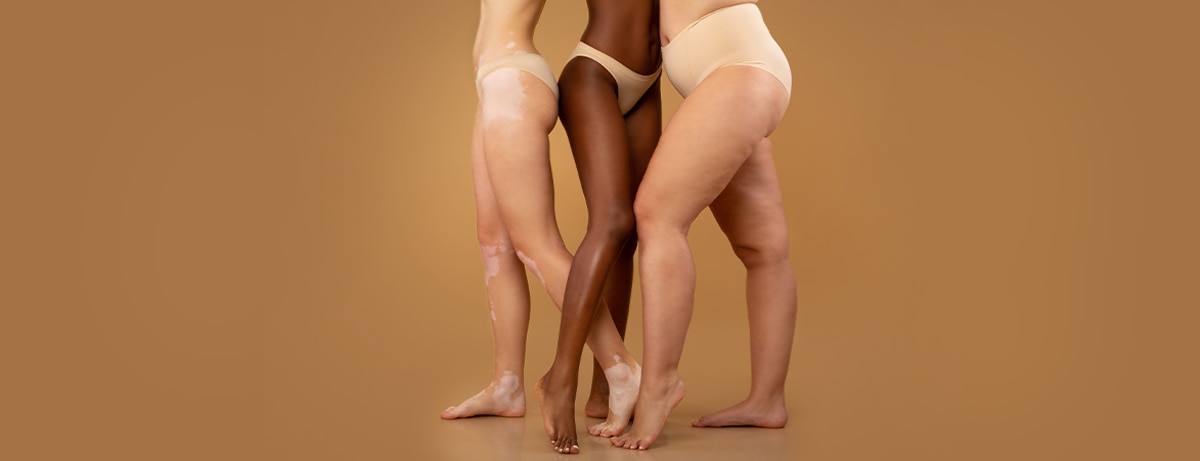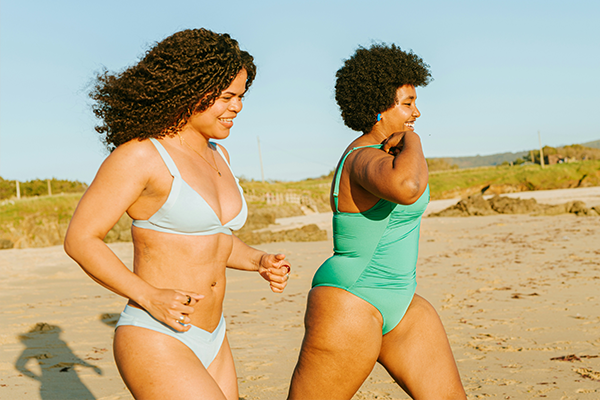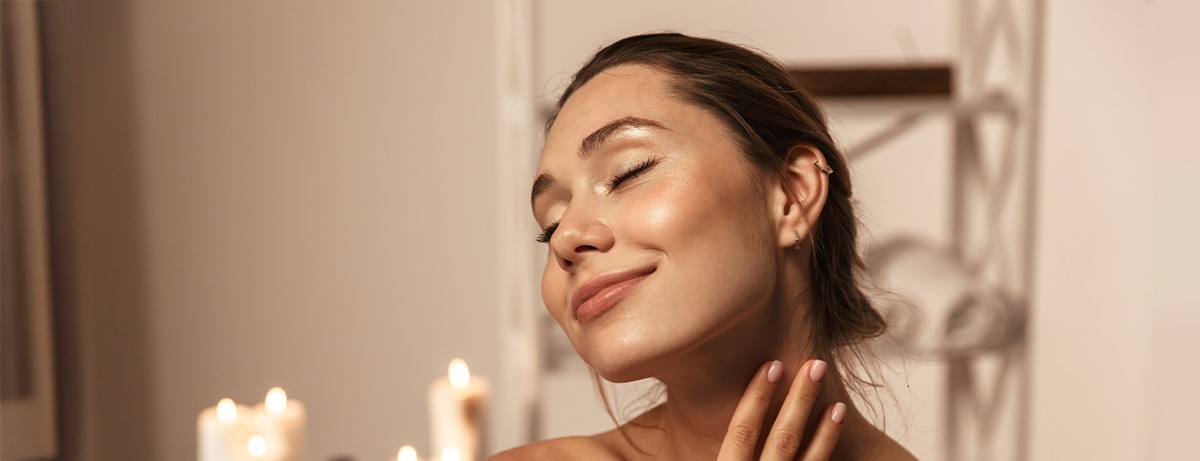15% off £25 or 20% off £35
Code:BASKET
Ways to help with your cellulite

Let's talk cellulite – most of us have it, but who says it has to be front and centre? It's natural, harmless and totally your call if you want to tone it down. Ready to smooth things over?
Summary
1A bit of background on cellulite: what is it and
The word ‘cellulite’ refers to skin changes that create dimpled or uneven texture on areas like the thighs, hips and bottom…
2What are the possible causes of cellulite?
It’s thought to form due to the interaction between the skin and fat layers beneath it, though the exact causes aren’t well understood…
3How to reduce cellulite?
While cellulite’s physically harmless, it can sometimes impact self-esteem…
Let’s clear the air: cellulite’s something nearly everyone has. It’s a natural and incredibly common feature of the human body, especially for women.1,2 Despite this, it has a bad rep – leading many people to feel self-conscious.3
But the truth is, cellulite’s normal and nothing to be ashamed of. For some, it’s just another part of their body, while for others, trying to reduce its appearance feels right. Whatever your perspective, there’s no right or wrong way to approach cellulite. It’s all about what makes you feel confident.
A bit of background on cellulite: what is it and who gets it?
The word ‘cellulite’ refers to skin changes that create dimpled or uneven texture on areas like the thighs, hips and bottom. These changes might give your skin the appearance of ‘orange peel’’.1
It’s thought to form due to the interaction between the skin and fat layers beneath it, though the exact causes aren’t well understood.1
Certain factors may influence how noticeable cellulite is, including:1
- weight – higher body weight can make cellulite more pronounced. At a higher weight, body fat deposits push more against the tissue under the skin, making cellulite dimples more visible
- age – ageing reduces the skin’s elasticity and collagen levels, potentially making cellulite more obvious
- hormones – hormonal changes, especially those related to oestrogen (for example, during pregnancy), can also play a role in how pronounced cellulite appears

How to reduce cellulite
While cellulite’s physically harmless, it can sometimes impact self-esteem. As a result, many people seek cellulite treatments each year.2
If you’re looking to reduce the appearance of cellulite, there are possible methods you can explore.1 This isn’t about ‘fixing flaws’ but about empowering you with information and tools to care for your body in a way that feels right for you.
Skincare: creams, oils and lotions
Many cellulite creams feature ingredients like caffeine or retinol, which work to improve blood flow, tighten the skin or reduce fat in the treated area. For example:1
- caffeine helps break down fat, boosts blood flow in the skin and acts as an antioxidant
- retinoids work by thickening the skin, promoting the growth of new blood vessels, building new connective tissue and increasing the number of active cells that support skin structure
While some evidence suggests that creams might help smooth the skin by improving cellulite severity and breaking down fat, most of these studies have been small and short-term.4-6 Since no ‘robust’ data is available, no cream is officially approved for cellulite.1
But, if you find cellulite creams, lotions and oils with ingredients like caffeine or retinol work for you, they can be a valuable addition to your skincare routine.
Supplements: collagen, plant extracts and fish oil
You may have come across certain pills or supplements marketed as cellulite solutions. These often include ingredients such as fish oil or plant extracts, like borage oil, which are believed to be beneficial due to their antioxidant properties.7 However, the science behind supplements for cellulite is very new and emerging.
Keep in mind that supplements aren’t a magic fix, but they could be a helpful addition to a healthy lifestyle and balanced diet.
Massage: lymphatic drainage (dry brushing)
Massage isn’t just for relaxation – in fact, it’s one of the oldest methods used to address cellulite.1
Some massage treatments even use specialised machines with suction and rollers to target cellulite. While these methods can make your skin feel firmer, it’s worth knowing that there’s no evidence to support long-term results.1,8
Lifestyle changes: diet, exercise, smoking and alcohol
Maintaining a healthy lifestyle, including a balanced diet, regular exercise, and reducing smoking and alcohol intake, is also a good idea for anyone who wants to minimise the appearance of cellulite. That said, while weight gain can make cellulite more noticeable, excessive weight loss may actually have the same effect.1
The final say
From simple at-home remedies like creams and supplements to solutions such as massage and energy-based devices, there are plenty of options to choose from.1 These methods have their benefits, but more research is needed to understand how long those effects last.
Want in on the science? Learn more about why cellulite happens in the first place.
Disclaimer - This article provides informational advice and is not a substitute for medical care. Curated by experts for accuracy, we take great care to ensure the information is up-to-date and relevant. However, you should always consult your GP or healthcare professional before using supplements or alternative products, particularly if you have medical conditions or are under supervision.
1. Gabriel A, et al. Cellulite: Current understanding and treatment. Aesthet Surg J Open Forum. 2023;5:ojad050. https://doi.org/10.1093/asjof/ojad050
2. Bass L, et al. Cellulite pathophysiology and psychosocial implications. Dermatol Surg. 2023;49(4S):S2–S6. https://doi.org/10.1097/DSS.0000000000003745
3. Endo. New Harris Poll Survey Shows 60% of Women Surveyed Feel It’s Their Fault They Have Cellulite [Internet]. 2020 [cited 2025 Apr 1]. Available from: https://investor.endo.com/2020-06-17-New-Harris-Poll-Survey-Shows-60-of-Women-Surveyed-Feel-Its-Their-Fault-They-Have-Cellulite
4. Roure R, et al. Evaluation of the efficacy of a topical cosmetic slimming product combining tetrahydroxypropyl ethylenediamine, caffeine, carnitine, forskolin and retinol, in vitro, ex vivo and in vivo studies. Int J Cosmet Sci. 2011;33(6):519–26. https://doi.org/10.1111/j.1468-2494.2011.00665.x
5. Dupont E, et al. An integral topical gel for cellulite reduction: Results from a double-blind, randomized, placebo-controlled evaluation of efficacy. Clin Cosmet Investig Dermatol. 2014;20;7:73–88. https://doi.org/10.2147/ccid.s53580
6. Turati F, et al. Efficacy of cosmetic products in cellulite reduction: Systematic review and meta-analysis. J Eur Acad Dermatol Venereol. 2014;28(1):1–15. https://doi.org/10.1111/jdv.12193
7. Luebberding S, Krueger N, Sadick NS. Cellulite: An Evidence-Based Review. American Journal of Clinical Dermatology. 2015 May 5;16(4):243–56. https://www.researchgate.net/publication/275895699_Cellulite_An_Evidence-Based_Review
8. Chang P, Wiseman J, Jacoby T, Salisbury AV, Ersek RA. Noninvasive Mechanical Body Contouring: (Endermologie) A One-Year Clinical Outcome Study Update. Aesthetic Plastic Surgery. 1998 Mar;22(2):145–53. https://link.springer.com/article/10.1007/s002669900182












